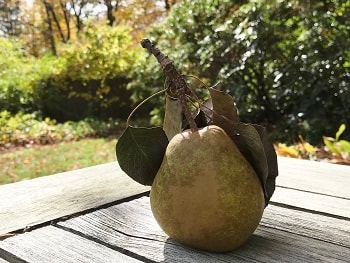|
Homer was early to declare his admiration of the pear in his poem, Alcinous’ Garden. Naturally, the Romans followed suit a couple of centuries later. The flower, fragrance and sweetness of pears had been prized in the east by the Chinese, who long cultivated the fruit to enhance its flavor and hardiness. Partridges notoriously prefer the pear tree to those of other fruits. The scent of a blooming pear orchard is so intoxicating that the bees must stagger in the air currents drunkenly seeking the source. Human consumption of pears left its evidence in the prehistoric pile dwellings of Switzerland, identifying a distinctly European variety. The Asia varieties continued to expand with the care of natural botanists. As things happen, east met west in North America and a new pear was developed by a 17th C, Pennsylvania farmer named Seckel. This Seckel pear has thicker skin, is grey-green in color and quite small. It is also the sweetest of pears, deservedly called by some either the Sugar Pear or the Candy Pear. Winter hardy, it thrives in the northeast. Oddly, pears ripen from the inside outward. When choosing a pear, one should test the flesh from the area surrounding the stem. If that part is tender, the pear is ripe. Due to the thickness of the Seckel pear’s skin, it can be stored for extended periods in a cool dry place. Nice to think of all that decadent sweetness once the land has tucked itself away for an annual winter nap. We have previously published many recipes displaying the pear’s talents, including: Anise and Port Braised Pears, Pork Tenderloin with Pear Sauce, Cranberry Pear Tart and Grilled Peppered Pears. Today our offered recipe is Pears Roasted with Wine, Vanilla, Thyme and Mascarpone.
0 Comments
Leave a Reply. |



